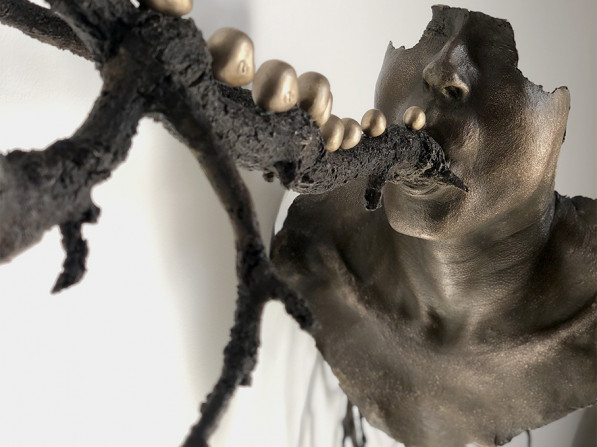Javier Pérez
Un soufflefrom April 6 to May 18 - 2024
print
Javier Pérez
Un souffle
April 6 - May 18 2024
Opening Saturday April, 6, 3pm - 8pm
Le temps d’un souffle - The blink of an eye
Javier Pérez's new exhibition embraces three lines of work which spread out like a rhizome in the artist's approach: each series is an offshoot that opens towards a new direction but remains linked to the body of work as a whole. Although unique, these three lines of work share a common anchor: the branch, the tree, the forest. Each work, an inner philosophical forest, is a temporal experience from which the energy of movement flows. A non-linear movement, made of polarities and endless recurrences. Like a wave. A breath. Materializing the pulse of life, creation and knowledge.
With Polaridad (2023-24), a set of four diptychs drawn in watercolor, pastel and charcoal on black cardboard, Javier Pérez's work materializes the movement of light. In line with the Caminos (2021-22) and Fuera del Camino (2022-23) series, based on photos taken in the forest, Javier Pérez has created a diptych of two drawings, one dark, the other brightly lit, in which the pattern seems to disappear. Through a unique use of watercolor, with the pigment barely diluted and worked in thickness, the artist transforms light into matter. A metallic matter, of mixed gold and silver, that covers the darkness of the support until it completely conceals it with its intense brilliance. A fragile frontier between inert nothingness and the radiant vibration of creation.
With the sculptures Los tres sueños de Descartes (2023) and the set of six drawings entitled Representación y Pulsión (desvelo de la razón) (2023), Javier Pérez's work situates itself on a new line of tension, bringing into play the free movement of plant forms against the linearity of geometric shapes. The organic and the living never cease to grow, to proliferate, over and beyond the limits of this linear order. It's as if the free energy of life was emerging in space, an energy that cannot be contained by the desire for control in our modern societies. Driven energy that pushes back the enclosures of what we think we know. Cracks of doubt germinating in our inner walls.
The group of sculptures and drawings entitled Inspiración – expiración (2024) embodies the fragile tremors of life. Faces spitting fire in the dark. Skeletons climbing spring. Flowers as powdery as ash. Death in an egg and vice versa. There's no linear or logical meaning. Only pieces of stories without beginning or end. Seeds and bones that come and go on the other side of the dial. Breathing out suns, breathing in winters. Life trembles only in this tenuous in-between. A flash of beauty in that space. The blink of an eye.
Amélie Adamo
Author, independent curator
March 2024